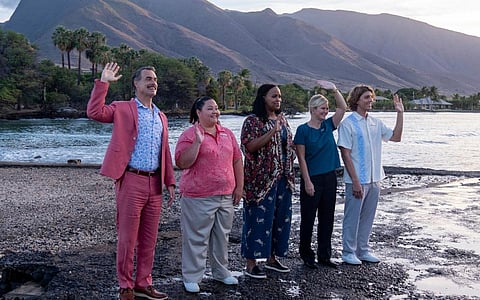
- Reviews
- Power List 2024
- Cannes 2024
- In-Depth Stories
- Web Stories
- News
- FC Lists
- Interviews
- Features
- FC SpecialsFC Specials

HBO's latest TV show The White Lotus practically laughs at a bunch of rich, white people, dying to be pampered during their one-week stay at a Hawaiian resort. In fact, the show's creator Mike White takes satire to a whole new uncomfortable level — each character is written with a disturbing amount of precision, their terrifying idiosyncrasies unravelling as the show progresses.
Newly-weds Shane and Rachel Patton (Jake Lacy and Alexandra Daddario) are not having the greatest honeymoon. While Rachel, a conflicted journalist, learns how controlling her rich husband can get, Shane can't get over the fact that the hotel's manager Armond (Murray Bartlett), who is on the verge of a relapse, put them up in the 'palm' suite when his mother (Molly Shannon) had paid for the pricier 'pineapple' suite.
The Mossbachers, like most dysfunctional families, can't stand each other. Nicole (Connie Britton) is a successful, liberal entrepreneur, who believes that rich white men deserve all the sympathy in the world right now with cancel culture and what-not. Her husband Mark (Steve Zahn), who has the ability to make everyone around him uneasy, finds out that his dead father had died from AIDS and not cancer, and wants to build a brutally honest relationship with his couldn't-care-less son Quinn (Fred Heckinger). Euphoria star Sidney Sweeney plays the 'woke' Mossbacher daughter Olivia. She gets to bring her friend Paula to the trip — the only person of colour among all the hotel guests.
On the other hand, Tanya McQuoid, played by the amazing Jennifer Coolidge, deserves a show of her own. Easily moved by people, whether they love or hate her, Tanya struggles to let go of things (this includes her abusive mother's ashes). She may be good at heart, but what makes her character so real is that she could seamlessly switch from being sympathetic to someone's struggles to finding peace in her own little bubble of privilege.
The White Lotus is a commentary on how rich white Americans continue to neo-colonise native cultures, exploiting members of the Hawaiian community for their amusement and entertainment. In the real world, they may wear masks of philanthropists, activists and policymakers, but when they are on vacation, they are just rich white Americans, discussing poverty and politics while sipping chardonnay.
Is Hawaii really so yellow?
What really bothers me about the show, however, is its off-putting yellow filter, typically used by Hollywood filmmakers to depict countries like Mexico, India, Bangladesh, or just any tropical region for that matter. Netflix's Extraction set in Bangladesh recently drew flak for using this yellow filter as a means to depict the 'under-development' and 'violence' of the region. These countries are more vibrant and colourful than their portrayal in Hollywood movies, but such visuals never make it to the screen because the West wants the region characterised in a particular way – hot, dusty and dangerous.
Movies with a subtle blue tint, on the other hand, are generally indicative of a region's progressiveness and modernity, and are usually set in the USA or Europe. Colourists say that these filters were initially used to indicate the temperature of the region and transport the viewers to a different space altogether, but over time, they began reinforcing a stereotype, perpetuated by the racist storylines of Hollywood films (a movie set in Mexico, say Bandidas, is usually all about its lawlessness, whereas a film like The Wolf of Wall Street depicts the modernity of New York).
The opening shot of The White Lotus (Shane waiting for a flight to Honolulu) is distinctly and unmistakably yellow. If the creator has, in fact, employed the yellow filter to depict Hawaii in a show that does not mince its words about cultural appropriation, then isn't it ironic, to say the least? Three minutes into the show, the viewer knows that something terrifying has happened at the resort. The jaundice-y yellowness coupled with an eerie soundtrack successfully creates a sense of uneasiness that one can't seem to shake off throughout the series.
While the show may not explicitly portray Hawaii as violent or lawless, Mike White's use of the yellow filter, which has been called out for its racist connotations, may be counterproductive to the show's satiric intentions.